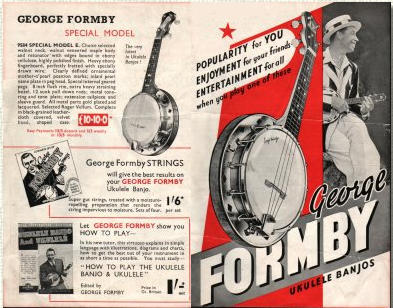
The banjo-ukulele pictured is a Dallas Type E, which was gold plated and presented to George Formby by the makers in 1930. Dallas manufactured (under license) four models of banjo-uke bearing George Formby’s signature on the headstock, from the ‘A’, which retailed for £1.50 and was best suited for use as kindling, to the ‘E’, which featured a walnut neck, ebony fingerboard, mother of pearl inlays and well constructed gold-plated pot assembly. The ‘E’ was nothing to be sneezed at, setting the purchaser back nearly £6 in its day!
In the wild orchestra days of the early 20th century almost all fretted chordophones were ‘banjonated’ to compete with the brass, and the ukulele was no exception. Many companies began producing ‘banjo ukuleles’ throughout the 1920’s, after Alvin D. Keech patented the name ‘banjulele’ in 1917. Their popularity throughout the 20’s is evident in that much popular sheet music of the time advertises tabulation for ‘banjo ukulele’, in spite of the fact that tuning is identical to that of ‘regular’ ukuleles.

Lancashire man George Formby is almost singularly responsible for the banjo-uke having survived beyond the big-band years. He enjoyed immense success as an entertainer, making the transition from the vaudeville halls where he got his start in the early 20’s, to the silver screen throughout the 30’s and 40’s. His racy innuendos and cheeky persona were not to the taste of stuffy post-war britain, and his popularity and health began to wane throughout the 50’s. Nonetheless he continued to perform until his death in 1961.
George Formby and his entry-level Dallas ‘signature ukes’ inspired generations of children (no doubt all ‘George Formby Ukulele Society’ card holders) to gain an inexpensive entry-point into the world of music.
This ‘Model E’ would certainly have been used by George for recordings and performance. His classic playing style required the use of certain fingerings, so he would perform with several ukes in different tunings on stage. His performance ukes used to have their ‘home key’ pencilled on to the vellum head, which can be seen in some live clips. It has been suggested that Formby abhorred the Dallas ‘signature ukes’ such that he would bandy them about on stage for the duration of the plug, then swap them out for an Abbott or Ludwig when it came time to play the song, as he did when swapping keys.
In the case of this instrument (#E/1169), the £6 asking price would have been well invested—after the death of George’s wife Beryl this uke was sold (via estate auction) to George’s son Frank, before making its way through the hands of Formby Society president Bill Logan to George Harrison—yes, that George Harrison—who eventually sold it back to George (Formby)’s nephew, Jeffrey in 1991. It was sold at auction to a private buyer in 2008.
Article courtesy of Melbourne based art historian and photographer Daniel Bornstein
www.danelbornstein.com